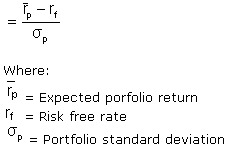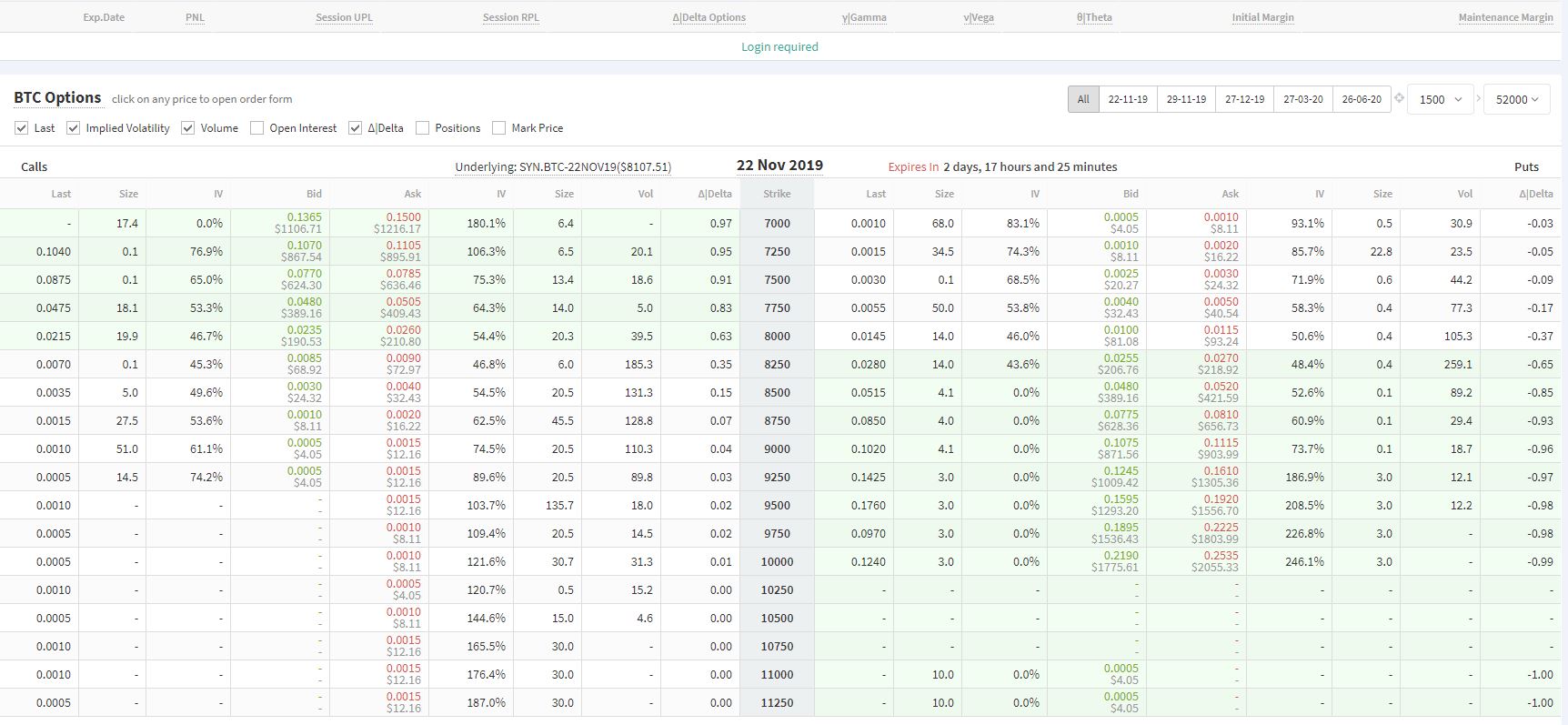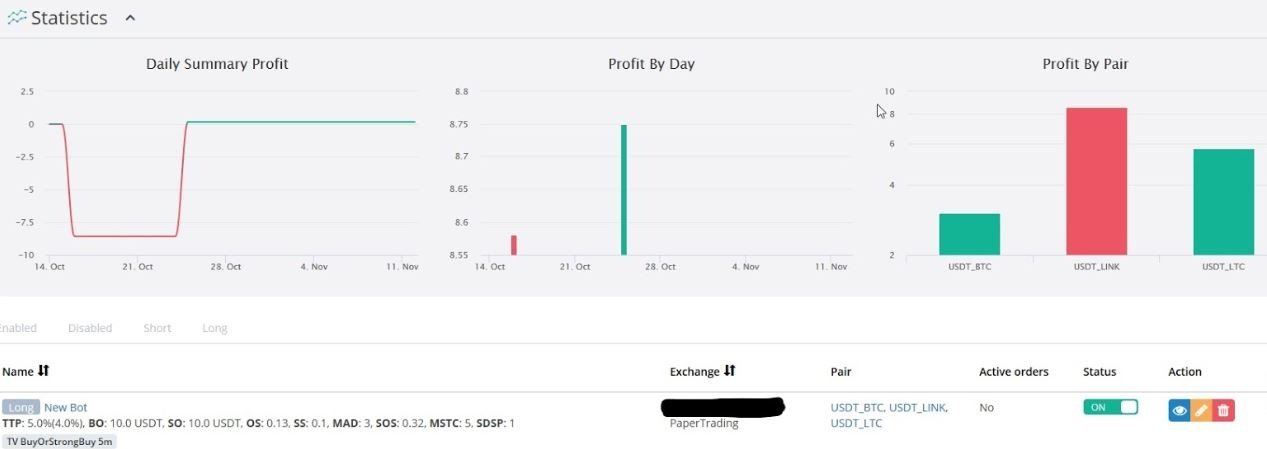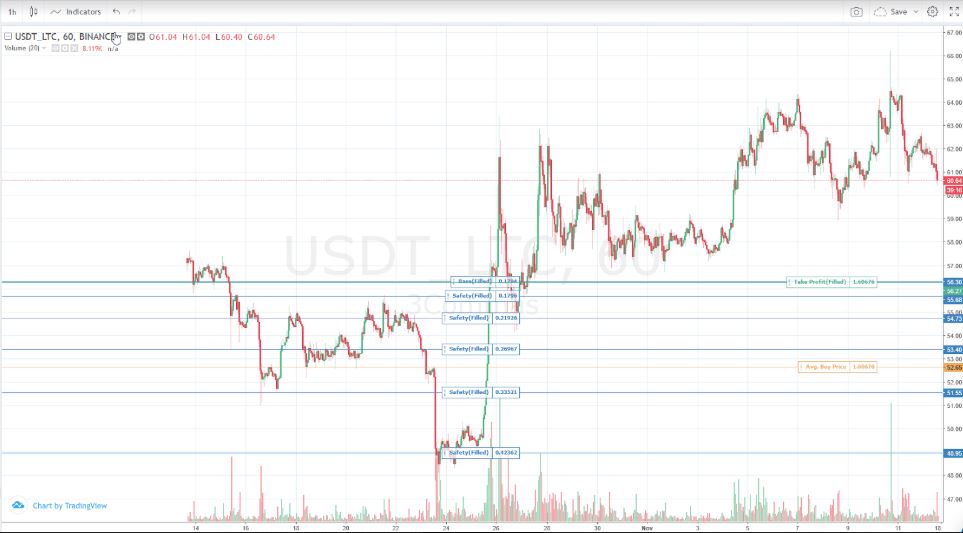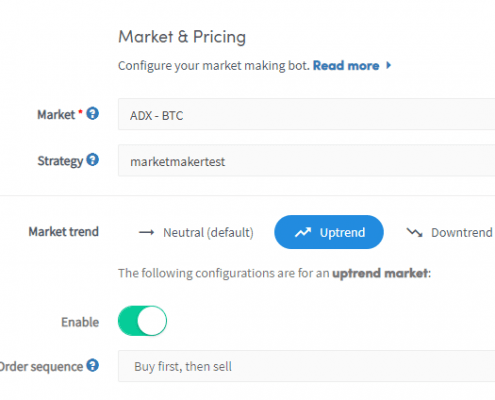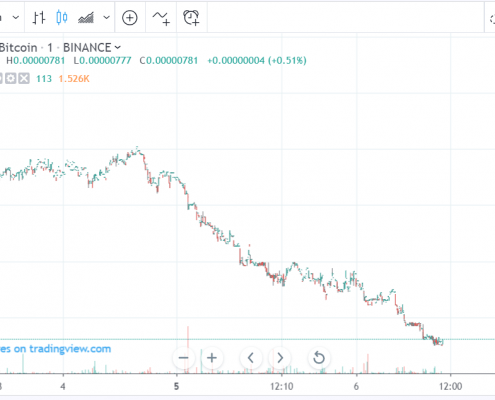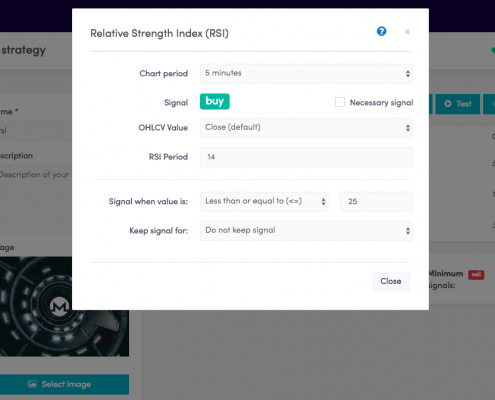From Crypto Signals to Profitability: the Path of a Crypto Investor.
How do you move from earning scraps off the crypto market to profitability? Like most crypto investors, you’ve had to or are probably still pursuing different paths to profitability. You’ve often asked yourself what it takes to succeed as a cryptocurrency investor. You’ve researched the different trade strategies, explored technical analyses, tried social trading, and even went after crypto signal providers. But none of these have what it takes to turn you into a profitable crypto investor.
In this guide, we detail the average crypto trader’s journey to profitability. We take you through the different stages most investors have to go through before they can eventually turn profitable. Almost always, it starts with manual trading crypto signals and social trading for crypto trading newbies before turning to automated systems. We explore this crypto evolution, detailing the different stages at which most crypto investors are currently stuck in before letting you in on the ultimate crypto investment strategy.
Crypto Evolution
An investor’s crypto evolution is the journey they have taken in pursuit of profitability. It’s more of a learning curve with a common starting point where most crypto traders begin their investment journey. In most instances, traders start by interacting with such manual trading strategies as crypto signals. Others opt for the fully-automated crypto trading bots that are synonymous with the promise of massive returns.
Soon, they will shift to the more flexible DIY crypto trading bots that allow them to tweak the trade settings. But all these have serious faults that either cause traders to lose their investments or not make any tangible returns at all. This dims their ability to progress to pro investors. Let’s look at the stages of crypto evolution before looking at the ultimate crypto investor tool.
Crypto Signals
Crypto signals are some of the most popular crypto trading strategies for beginners. This involves linking up with a crypto signal provider, receiving trade signals, and entering into the guided positions. Different crypto signal providers, however, adopt varied tactics in their approach of the trade, with significant differences in, for example, the number of currencies they monitor, the mode of signal distribution, and signal fees. Let’s look at this in more detail:
Who Is a Signal Distributor?
Anyone with basic knowledge on how to interpret crypto charts can set up a crypto signal distribution service. A crypto signal provider is an individual or company that sends out crypto trading ideas and suggestions that its subscribers/followers can use to enter into trades. In most cases, these providers will claim to be crypto professionals or highly experienced traders. They will claim to have mastered the trade and are now just looking to help others, especially newbies, turn a coin trading the highly competitive crypto markets.
Crypto signal providers believe and have their followers believe that one can understand the markets by merely looking at the charts. They hold the opinion that they can understand the future of the markets by simply looking at its past operations. But they are wrong. And this line of thinking stems from the inherent human inclination to believe that we can draw patterns from even the most random data.
A signal service provider can also be a cryptanalysis algorithm programmed to identify the best trade entry points. When these points are triggered, the system sends out automated crypto trading signals to its subscribers.
Three types of providers, mainly the professionals that analyze the markets manually, algorithmic systems and a hybrid of algorithm and professionals traders dominate the crypto signal market. The professionals will send out signals based on the results of their market and chart analysis.
Automated traders, on the other hand, have automated systems that send out trade signals as soon as their preset trade entry triggers are hit. The hybrid signals providers, however, use the algorithms to analyze the market and identify trade entry points. But the automated trader’s results have to be counterchecked by a professional before being released to subscribers. They nevertheless have one thing in common; they all base their analysis on the results of a combination of technical analysis tools, latest news, rumors, and market conditions.
The Signal
The trade signal comprises of three critical parts: the trade entry price, the take profit price, and the stop-loss price. Depending on whether you’re dealing with free signals or paid signals, the provider will advise you on the minimum trade amounts for breaking even and maximum profitability.
Some trade signal providers may also offer additional information such as analysis of the different trade prices like the entry price or stop-loss levels. But given the time-sensitive nature of these signals, the provider will only send out the trade entry points first and the information supporting these trade points much later. You, therefore, need to fully trust that the cryptocurrency signal provider has your interests at heart given that you will enter into virtually all crypto trades blindly.
Who Uses Crypto Signals?
Crypto signals are primarily used by crypto investment beginners that can’t yet skillfully analyze the crypto markets and accurately identify the best entry and exit points. Part-time crypto investors who don’t have enough time to properly analyze crypto markets and identify the trade entry or exit points have also mostly relied on crypto trade signal providers.
Depending on signal providers to help you get into trades, however, calls for a lot of trust on the part of traders. This means you need to properly vet the signal providers before subscribing to their services. You need to look at factors such as the experience and professionalism of the individuals behind the service.
You also need to look at their win-to-loss ratio and only subscribe to the provider with the highest win ratio. Additionally, you need to consider the frequency of their trades, their subscription fees, and minimum trade amounts as well as the mode through which they distribute these trading signals.
Modes of Signal Distribution:
There is a very short window of time between receiving the signal and entering into a trade. The speed at which you enter into a winning signal ultimately determines how much you make from the trade. As such, signal providers try to use efficient modes of communication in delivering these signals to as many of their subscribers as possible. Some of the most common modes of signal distribution include:
Texts: Text message is one of the most effective and most popular method of delivering the best crypto signals. The fact that virtually everyone has a phone makes it the perfect signal distribution tool. The text message alert is also hard to ignore.
Telegram bots: Telegram messaging comes in as yet another favorite for most signal distributors. It’s easy to see why it’s the most preferred communication tool. To begin with, it has an alert system similar to that of the text message that’s hard to ignore. Secondly, Telegram allows for the development of automated trading bots that are easy to integrate into the trading systems. These will automatically enter into a trade immediately the signal is received using preset trade parameters.
Emails: Emails also count as a form of signal distribution. However, most signal providers only have them as an alternative distribution option for the text or telegram messages. Sending signals via email isn’t popular and will only work for international clients.
But latency of these channels puts investors at a huge disadvantage in comparison to for example trading bots.
Charges and other fees
A cryptocurrency signal distribution channel can be either free or paid. INFOCRYPTO and Fat Pig Signals are two of the most popular and considerably accurate free signal service providers. These two are telegram based, meaning that most of their signals are delivered via telegram bots. There’s also a host of popular paid cryptocurrency trade signal providers that charge a monthly, quarterly or annual subscription.
Why you shouldn’t consider trading signals as a crypto investing strategy:
- Virtually anyone can open an online crypto signal distribution service and charge a subscription fee. This tells you that signals providers are out to make money – not by trading but from selling untested signals. Furthermore, if these signals were as profitable as they claim, they would open trades, not sell them.
- Most virtual signal providers indicate a disclaimer that their signals are just suggestions, hence no guarantee you will profit from their execution.
- You are obliged to pay the subscription fee whether you win, lose, or fail to trade all their trade suggestions. Most will also prefer upfront payment that compounds the loss incurred from trading fake signals.
- Most will either demand for minimum trade amounts or have their subscriber fees so high that you have to commit significant trade amounts if you wish to break even
- Latency in manually entering the trade may make the signal invalid or at best diminish potential profits
Social Trading Cryptocurrency
Social trading is one of the easiest approaches to investment. It works best for both new part-time traders and investors. To successfully invest in cryptocurrencies, you need a thorough understanding and experience in analyzing the markets. You also have to stay on top of recent news and events around the crypto industry. And lastly, you have to be adept enough to predict the impact of current trends on the price of digital currencies. Social trading and the different social trade platforms that actively promote and allow copy trading can enable you to bypass the need for industry experience.
How does social trading work?
Social trading is a form of networking in crypto trading that involves sharing trade ideas and signals. The most popular form of social trading today is copy trading. Copy-trading allows a trader to copy the trade strategies of another more experienced trader. Interestingly, social trading can be implemented at both the trader expert levels exchange and trading platform level. eToro, ZuluTrade, and NagaTrader are some of the crypto trading platforms that lead the pack in supporting copy trading.
Usually, such providers will have a list of expert traders on their platform that allows others to copy their trades. Highlighted on their profiles will be such factors as their win ratio, trading frequency, coins invested in, risk tolerance levels, and historical trade accuracy. The platform will then charge either a subscriber fee or a commission on earned profits. For instance, eToro charges copy traders 20% of profits made from copying trades.
Like crypto signals, copy trading ensures you don’t need crypto trading experience to invest in cryptocurrencies. You only need a platform that lets you copy trade while maintaining the lowest social trading fees and commissions. You also need to master the art of identifying the most viable expert trader to copy from, paying particular attention to their win ratios and risk tolerance levels.
Why social trading is not the best approach to crypto investing:
- There is no guarantee that the expert trader you are copying will continue with their winning streak or good performance
- You will not always find an expert trader you are compatible with, especially when it comes to risk ratio
- Some platforms charge exorbitant fees and commissions that negatively influence your results in the long run
- Fee structures can push expert traders on the platform to risk-seeking trades thus wiping out trader accounts if the markets don’t go their way
- Social trading doesn’t create enough room for investment portfolio diversification, which additionally puts large risks on investors
BlackBox Crypto Bots
The internet and the cryptocurrency trading space isn’t short of BlackBox crypto trading bots. These are tools that claim to automate the entire crypto trading process and help you scoop unprecedented profitability, while all you have to do is buy the bot or subscribe to their service. According to their vendors, you don’t need to be a professional or highly experienced crypto trader to profit from crypto trading as these pieces of software have the work cut out for you.
The bots and software are fully automated and require little to no effort on the trader’s part. They also have efficiency, speed, and accuracy as their biggest selling points as their vendors boast of their ability to outsmart an average trader both in trade analysis and execution speeds. But even with these seemingly elite features, they have serious faults that make them unfit as a crypto investment tool.
How Crypto Bots Work
Ideally, a crypto bot is an automated trading software that crawls the cryptocurrency market looking for the best trading opportunities. Crypto bots usually follow a specific set of trade instructions when analyzing the market and identifying the best trade opportunities. These instructions are based on factors such as technical indicators, trends or price levels.
With most of the black box crypto trading bots, the settings are designed and updated by the developers of the automated trader. They leave little to no room for customization. Most are online-based as this makes it easy for developers to tweak or overhaul the trade settings more conveniently. However, when dealing with offline trading bots, the provider will send you a link where you can download new or updated trade settings and manually load them on to the bot.
Most of these bots have also embraced different levels of specialization and most crypto bots available in the market today are either coin specific or exchange specific.
Coin specific bots
These are crypto bots that are centered on the performance of a single coin. The most popular is the bitcoin bots that track and monitor bitcoin activities. Their trade settings are centered on the legacy cryptocurrency and can, therefore, only be used to trade bitcoin and bitcoin cash. They are referred to as black-box bots because there is little you can do to tweak their trade settings and their logic is generally hidden from your eyes.
Exchange specific bots
These are crypto bots developed and distributed for one crypto exchanges and its API. The bots are developed by independent crypto analysts and traders but still center on the operations of a specific exchange. Exchange specific bots will only trade some or all the coins listed on the exchange. Note also that most of the exchange specific bots often align themselves with some of the most popular exchanges like Binance, Coinbase or Gemini. They are especially popular with crypto exchanges that support leveraged crypto trades like BitMex, Kraken, and Deribit.
Who can use the bots?
Inexperienced traders: Most of these black box crypto trading bots are marketed as the ultimate hands-free and wholly passive approach to trading. And this appeals most to inexperienced crypto traders looking for a quick way to make money off the crypto market. The automated crypto trading tool especially comes in handy in allowing the inexperienced crypto enthusiast to scrap small profits from the market as they learn how to trade.
Part-time traders: Part-time crypto trading isn’t the best approach to crypto investing. The crypto market is highly volatile and leaving trades open for long – with insufficient risk management protocols in place – can expose a part-time trader to unimaginable losses in case of unexpected market downturns. Trading part-time also means that you have less time to effectively analyze the markets and set up informed trades. For this reason, most of the part-time traders have, therefore, turned to automated crypto trading bots. Their ability to use preset trade settings and incorporation of sufficient risk management tools ensures that they only enter trades when conditions are ideal.
Why crypto bots aren’t the best approach to crypto investing:
- Crypto bots are highly complicated software and arriving at a quality bot involves a lot of trial-and-error and loss of valuable capital.
- There is a lot of secrecy surrounding these automated crypto trading bots. Hardly will you ever know their developers are and this makes it hard to trust a system with your cash when you don’t know the professionalism or ethics of its developers.
- Most crypto trading bots are cloud-based and will automatically receive and execute trade signals or trade settings. They claim to use technical analysis to identify trade opportunities but will never reveal some of the indicators or trade strategies that they use.
- Fraudsters and privacy compromisers have continually targeted and infiltrated the automated crypto trading niche. Also, we still don’t have a proven method of vetting the quality of bots, the experience of their developers, the effectiveness of their strategy, and how they handle private data.
- Some automated crypto trading bots have proven time and again to be a scam only interested in your subscription fees and private data like exchange keys, and vanishing as soon as they have both. You will end up with not only your privacy compromised, but also lose both the bot subscription fee and the crypto trading capital you had invested.
- No opportunity to learn: Since everything is automated, plus the bot doesn’t share the trading strategies and technical analysis indicators used to arrive at the trades, you never get to learn how to trade.
DIY Crypto Trading Bots:
After trying crypto signals and facing the disappointment that is black box crypto trading bots, the crypto investor’s evolution journey pushes them to the DIY crypto trading bot. These DIY trading bots are automated cryptocurrency trading tools. Unlike the black box auto trading tools, however, the DIY auto traders are more professional and more transparent about their system designs and trading strategies.
They also claim to rely on technical analysis and elaborate trade strategies to analyze the market. Their DIY nature also sets them apart from the wholly automated black box auto traders that do not leave room for the customization of trade strategies. With crypto trading bots, you can tweak the default trade settings to align with factors like your risk tolerance.
Their highly transparent nature also makes it easier for you to better understand how the crypto market works. For instance, you can tell the strategy used by your DIY trading bot which technical analysis indicators should be used in monitoring the market. You can also vet its trade entry and exit decisions by setting the factors the bot takes into account before opening a trade position, risk management protocols observed for each trade, and factors triggering a sell-out and exit.
These are all part of learning that help you become a better crypto trader. In essence, the DIY bots address the inherent limitations of relying on crypto signals and the black box crypto trading bots in kick-starting your crypto journey. Two of the most popular DIY crypto trading bots in the market are CryptoHopper and 3Commas. Let’s take look at each of these below:
How Cryptohopper Works:
Cryptohopper is a Ruud Feltkamp’s project that’s currently available to crypto traders in both automated and semi-automated versions. The bot uses market and exchange arbitrage to make profits. The Cryptohopper app is also a strategy design tool that allows the user to customize trading strategies.
Cryptohopper uses technical analysis indicators such as RSI, EMA and Parabolic Sar to scan the markets. Its semi-automatic version is more of a social trading tool that copies the trade strategies of the most successful day traders and sends them out to the rest of the community.
The semi-trading bots scour the market for the best performing trade strategies, copy them, and present them to the trader. It sources trade signals from different traders and forwards them to the trader. The bot essentially presents the trader with a choice and they get to only implement the signals that they feel best matches with their trading strategy.
How 3Commas works:
3Commas describes itself as a smart trading terminal and a combination of trading bots. It features both auto-trading and manual trading systems and uses technical analyses to monitor the charts and markets around the clock. Some of the technical indicators used on the platform include CQS scalping and RSI. Plus it also supports social networking and copy-trading.
Limitations of the DIY crypto bots as professional investment tools:
While the qualities and trading features of the DIY crypto bots dwarf the crypto signals and black-box crypto bots, they are still a far cry from helping traders reap maximally from the crypto market.
- They are based on the idea that finding the right combination of simple technical analysis indicators can bring profits. Maybe it could, but this needs very good backtesting capabilities with large datasets of historical data, which all of these platforms lack.
- With current states of computing, finance, and mathematics, there are more advanced tools available than moving averages or other technical indicators capable of identifying patterns on the market
- These platforms lack the technical performance needed to react to market events. A latency of a minute or seconds outperforms signals or social trading, but is not enough to win the algorithmic race. On the contrary – you are an easy target for more sophisticated algorithms.
- Most DIY crypto trading bots have highly complicated set up processes and getting it wrong at this stage sets you up for losses every time you enter a trade
- Dealing with the bot signals and their different trade settings like where to place the stop loss and take profit levels can be quite confusing
- Most DIY bots are premium service providers that charge subscription fees. Mostly, the profits you make off your returns and time spent configuring trade settings aren’t always commensurate with the subscription fees. They have a high expense to income ratio which makes them unideal trade platforms
- Most of the DIY cryptocurrency trading tools pay more attention to social trading than educating the subscriber on how to improve their trading skills
- Most of the bots are poorly maintained and thus prone to system lags that in turn result in expensive slippages.
Ultimate Crypto Investment Tool: Professional Trading Bots
After looking at the different stages in a crypto trader’s evolution journey towards profitability and why they don’t work, you must now start revaluating your trading style. And looking at some of the reasons why it doesn’t work, you can tell that there is little you can do to turn these trading strategies around. In such a case, what are your options? Who do you turn to, especially if you are looking to undertake significant crypto investments? Well, you can always turn to professional trading bots used by expert traders and institutions.
How Do Professional Trading Bots Work?
These too are automated cryptocurrency trading systems and work to achieve pretty much the same goal as the DIY and black box crypto trading bots. However, they differ from the rest of the automated trading bots in profitability. Unlike the crypto signals and the rest of the automated tools provided by faceless individuals and companies with questionable crypto trading experience, professional bots are designed and tested by pioneer crypto traders and some of the most experienced crypto and money market trading professionals.
You will nonetheless appreciate the fact that most of these bots and platforms are proprietary and expensive. The high price is in appreciation of the time and effort as well as the resources utilized to come up with such a bot and underlying a platform that can react to market events in milliseconds, processing information on hundreds of instruments in real-time. In most instances, these bots often take months or years of hard work from highly qualified teams of professional quants and crypto traders.
Who Uses Professional Trading Bots?
Professional traders
Developing sophisticated and profitable systems requires huge time and capital investments. You need enough money to hire quants to create, test, and roll out these algorithms.
Hedge funds
Hedge funds are the primary inventors and beneficiaries of these professional crypto trading bots. They have funded the development of and own more proprietary algorithms than any other entity. And they present you with the best chance of having the professionally developed crypto bot work for you. Most don’t discriminate and will welcome any client on board as long as you can raise their minimum initial deposit.
Institutional investors
Institutional investors like mutual funds and private equity funds may also come together to fund the development of proprietary cryptocurrency algorithms.
What makes professional trading bots superior to all other approaches to crypto investing?
Here are the unique factors that make professional trading bots better than the conventional DIY and BlackBox auto traders, as well as reasons why you too should consider using one.
- Execution strategies: Virtually all professional trading bots use a combination of different trade execution strategies. And they are all aimed at helping the bot achieve maximum profitability with every executed order. The most common include:
- Smart order routing: Professional cryptocurrency bots aren’t crypto or exchange specific, but are specially designed to monitor the entire industry for the best prices. The algorithm is constantly scouring the markets looking for an exchange with the most promising prices for your orders and executing trades automatically.
- Advanced order types: A professional crypto trading algorithm also uses advanced order types not available to the retail auto traders. These include the iceberg order that hides the real size and value of your orders to ensure the market doesn’t go against you. Alternatively, it could employ the pegged order system where the algotrader passively follows the highest list of trades in the order book in a bid to achieve the best execution prices.
- TWAP and VWAP strategies – are execution algorithms that help you make large trades without influencing the prices
- Passive strategies: The bot will have liquidity provision strategies like market-making. These involve hedging and exposing your capital to minimal risk while benefiting from differences in spreads.
III. Arbitrage strategies: Arbitrage involves buying one cryptocurrency on one exchange and selling it on the other to take advantage of the price differences. It can either be standard arbitrage that involves just one cryptocoin like Bitcoin or Ethereum, or triangular arbitrage for more advanced bots that take advantage of the price difference of up to three coins in different exchanges. Other arbitrages will go as far as specializing in statistical arbitrage and cross-trading a portfolio of crypto assets simultaneously in different exchanges.
- User-defined strategies: Some bots will also have a host of advanced and statistics-based execution strategies that capture and process the widest range of data in the shortest periods to provide the trader with multiple possible correlations that can be exploited to create maximum profitability opportunities.
- Connect to both multi-list and niche exchanges: Bots for long running of stable strategies need to have regularly updated connectors to all the major crypto exchanges like Binance and Coinbase. It should also have connectors to the not-so-popular niche exchanges and over-the-counter crypto platforms. More important than the long list of connected crypto exchanges is the quality of these connectors. Exchanges are constantly changing their APIs and a professional firm who monitors and updates its connectors fast can defend you from losses that would arise from connectivity issues.
- Managed and updated by professionals: Unlike the basic crypto algorithms from faceless providers, the developers of different professional algorithmic traders are industry leaders. They are charged with the day to day management of the system by keeping it and your invested capital safe, updating its core features regularly and ensuring that it maintains optimal performance.
How do you access the professional trading bots?
We already mentioned that these professional bots have for the longest time been a preserve for the capital and digital asset management firms like hedge funds and investment banks. They are proprietary property and the tools behind the success and consistent profitability posted by these firms. Traditionally, you would have to first research the different hedge funds, looking at what they say about the features of their bots before raising a high minimum initial deposit to become one of their clients.
The recent past has however experienced a gradual change in the finance and investment industry with most institutions moving away from the traditional and rather rigid modes of business. And with this industry shift, most of these professional bots have been availed to the retail market at affordable terms for the average investor. Therefore, you no longer have a reason to continue clinging on to the frail crypto signals, the deceitful black box auto traders, the faceless ‘expert’ developers or the expensive and unprofitable DIY cryptocurrency trading bots. Learn how to access the professional proven and tested professional trading both here and start recording hedge-fund-like profits.

